Feeding your chickens a healthy, balanced diet is a massively important piece of raising a healthy flock.
If you want hens that lay lots of eggs – or broilers that produce large, juicy breasts – you need to think carefully about what you are feeding your flock.
In our ultimate guide to feeding chickens, we will tell you everything you need to know to raise a healthy flock – from what to feed your chickens to how much (and everything in between).
What You Will Learn – A Quick Guide
Here are a few things that we will cover in this article:
- What chickens eat in the wild
- Basic feed requirements
- Types of chicken feed
- How to feed baby chicks
- How to feed meat chickens
- How to feed egg laying hens
- Making your own chicken feed
- How much / how often to feed your chickens
- How to save money on your chicken feed
- Types of chicken feeders
- Healthy treats that you can feed your chickens
- Foods to avoid feeding your chickens
What Do Chickens Eat in the Wild?
To be fair, feeding chickens is not always as simple as it might seem to be.
You need to provide a diet that closely mimics what your chickens would consume in nature – meaning you need to understand the unique digestive system and anatomy of the bird.
In the wild, chickens are opportunistic feeders.
As omnivores, free-ranging chickens will eat anything from worms and slugs to crawling bugs, tender fruits and greens, seeds, grains, and even rodents or small birds.
They will even eat lizards of scratch in the manure of other animals to find larvae, insects, and undigested grains.
Chickens will even eat meat – when given the opportunity, they will also go after animal products like dairy and eggs, too.
Because of this widely varied diet, a chicken in nature will consume a vast array of vitamins, minerals, carbohydrates, protein, and fat.
A chicken that is being raised in confinement (even one who is allowed to free range most of the day) has the same nutritional needs, most of which can be provided for by giving your birds a combination of commercial or homemade foods.
Basic Feed Requirements
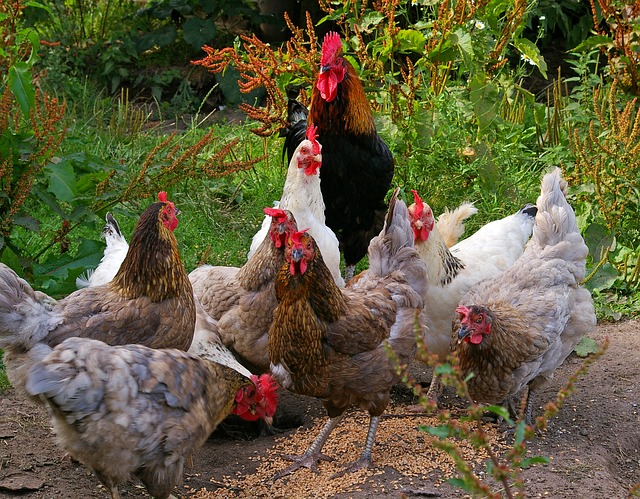
If you’ve ever bought a bag of commercially produced chicken feed, you’ve probably wondered what makes it so special.
How do the producers know what ingredients chickens need to be healthy?
Simple – Lots of science, and many years of research.
Over time, grain producers like Manna and Purina have produced and refined the perfect blend of ingredients to meet the nutritional needs of poultry.
Commercial feed is formulated to maximize the growth potential of each and every bird.
But “back in the day,” as they might say, your grandparents probably weren’t buying chicken feed from the store.
Instead, their chickens were fed with a mixture of table scraps, foraged greens, and whatever else they could find while scratching in the backyard.
However, there are some needs that your chicken needs to have met that can usually be found in the wild – but that you can only guarantee they will receive by providing it to them in a feed mixture.
Here’s what your chickens need to stay healthy:
- Protein: Every chicken feed, regardless of whether it is designed for chicks, laying hens, or broiler birds, will contain protein. The exact amounts will vary depending on the type of bird it is formulated for.
- Amino Acids: Chicken feed will all contain essential amino acids like methionine and lysine.
- Vitamins and Minerals: There are lots of vitamins that chickens need, but the most important ones are A, D3, B12, E, copper sulfate, and phosphorus.
- Fiber: Chicken need plenty of fiber and enzymes to aid in digestion.
Some other feeds may contain ingredients like omega-3s or additional nutrients depending on the specific needs of the flock.
If you’re curious about what your chicken feed contains, just take a look at the label on the bag.
Types of Chicken Feed
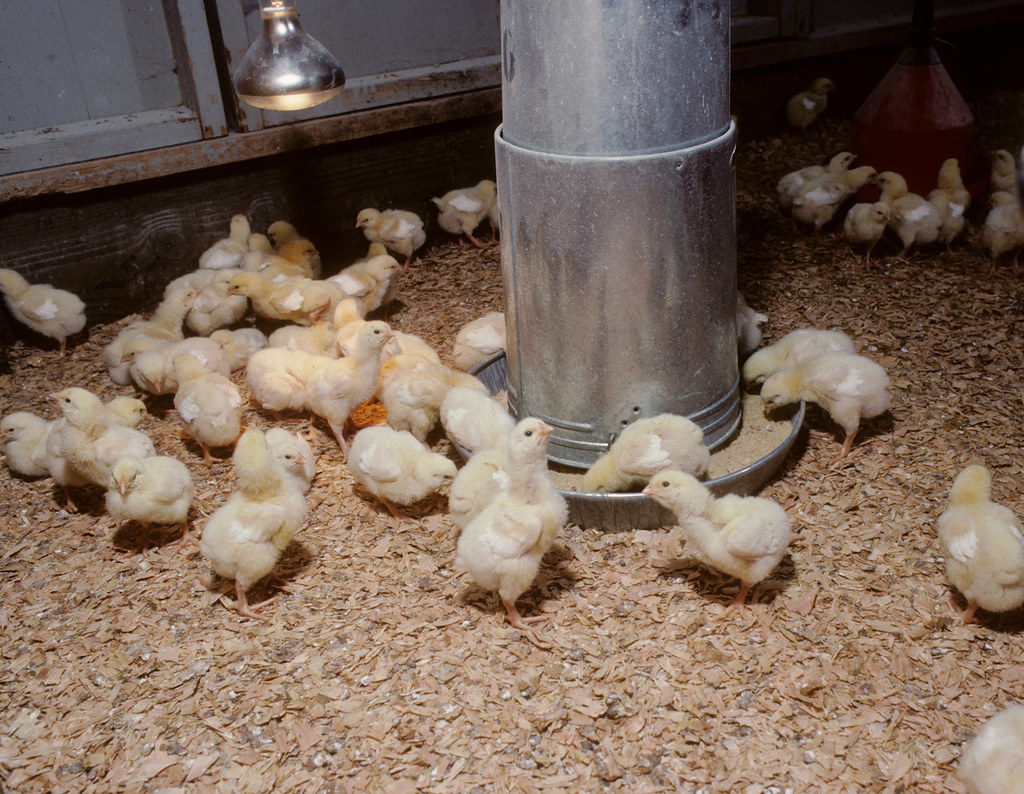
Beginning at day one of your chicken’s lives, you will need to feed it chick starter.
Chick starter feed will be broken down into two categories: medicated or unmedicated.
Medicated feed has been treated with a coccidiostat to help your chicks prevent diseases caused by coccidian protozoan.
Unmedicated feed, of course, does not contain this.
It is up to you whether you want to purchase medicated or unmedicated feed – just make sure you only feed chicks chick starter.
When your chickens become pullets, they can be switched to layer feed or broiler feed.
Layer feed has 16% protein and should not be given to birds unless they are lying.
Broiler feed will contain even more protein to help accelerate growth.
We’ll go into more detail about the various types of feed for flocks in a moment, but for now, we’ll tell you more about the different forms that you can purchase chicken feed in.
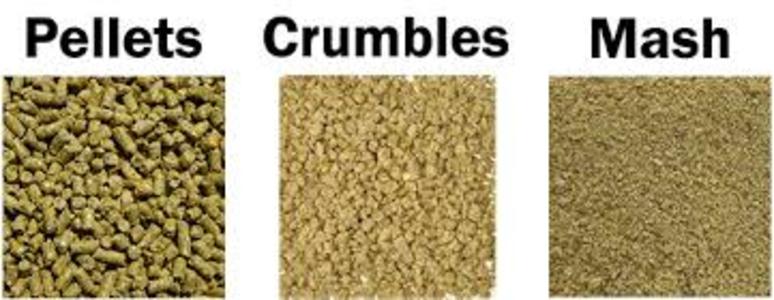
Feed can be purchased as mash, pellets, or crumbles. These terms simply refer to the texture of the feed.
Mash
Chicken mash looks a lot like potting soil.
It’s the easiest for your birds to digest and very fine-grained.
Most chick starter will be in mash form, since it’s the easiest for your birds to handle. Adult chickens can also be fed mash.
It is lightweight and is easily blown all over, making it messier, but it’s a good option during molting season, when it’s easier for your birds to process.
Crumbles
Crumbles are more like granola, and while they’re coarser than mash, they aren’t quite as hard as pellets – which we’ll talk about in a moment.
Crumble is easier to manage than mash, lacking the powdery consistency that makes it tough to feed.
If you’re trying to transition your birds from mash to pellets – or vice versa – crumbles are a nice intermediary solution.
Pellets
The final option – and probably the most popular – is pellets.
Pellets are hard, compact units of food that are commonly fed to adult chickens.
They produce minimal mess and waste but again, are a bit more difficult to digest by your bids. You should not feed young chickens pellets.
Feeding Baby Chicks
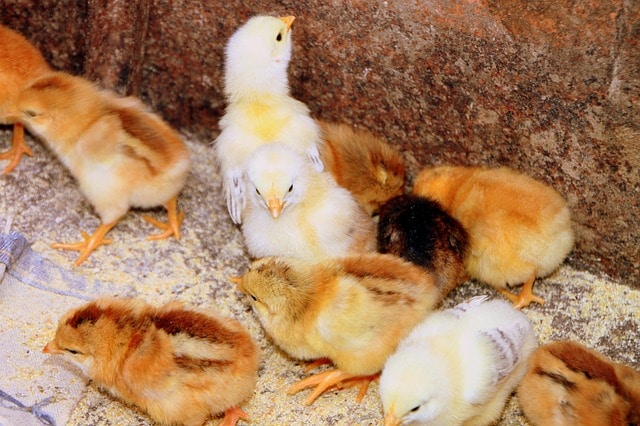
Baby chicks technically don’t need any food for the first few days of life.
These little cuties will live solely off the yolk of the gg from which they were hatched.
This is why you can easily receive eggs shipped from across the country without having them sent with food or water.
After a few days of digesting yolk, however, your chicks need to be fed lots of real food.
When you are feeding your freshly hatched chicks, you might be tempted to try to save some money by feeding them the exact same foods you are giving to your adult birds.
Don’t give in to this temptation!
You need to give your baby chicks a specially formulated diet that will help them grow at this early stage of life.
Chick starter, or starter feed, is the food you should give your chicks from the point of hatching until at least six weeks old.
After six weeks, you can slowly transition your birds to a grower feed.
Starter feed has about 20 to 24% protein to help your chickens grow.
It will boost their metabolism and enable them to grow and feather out rapidly.
Feeding Meat Birds
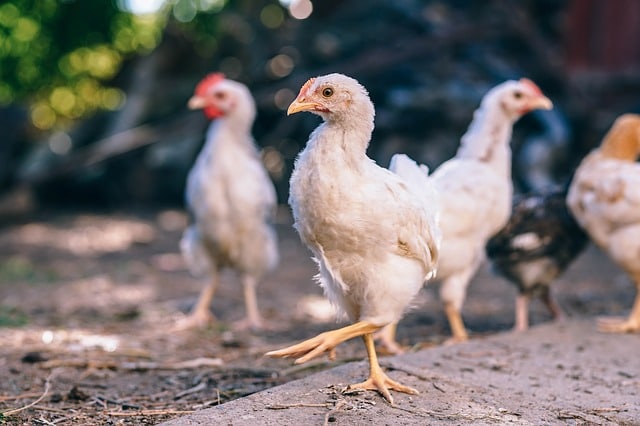
Meat chickens are fed just like any other kind of chicken – except they need lots of protein in order to grow quickly.
If you don’t give your meat birds enough protein, they will fall behind and may begin to show significant signs of illness.
Broiler chickens don’t live very long – unless you are raising a dual-purpose bird that is designed for both egg and meat production, this is probably the whole point as to why you have chosen a meat bird to raise.
Broilers usually only live for 5 to 20 weeks before they need to be culled, so during this time, you must feed them a high protein diet in order to produce full-length growth.
Most meat bird feed has a protein content between 22 and 24%.
If you’re not sure what kind of food to buy, it’s simple – just look for a broiler breed feed that has that marked clearly on its label.
In many cases, you may also be able to feed your broiler chickens game bird feed, but it’s important that you check the specific formulation to make sure it’s safe for your flock.
Feeding Egg Laying Hens
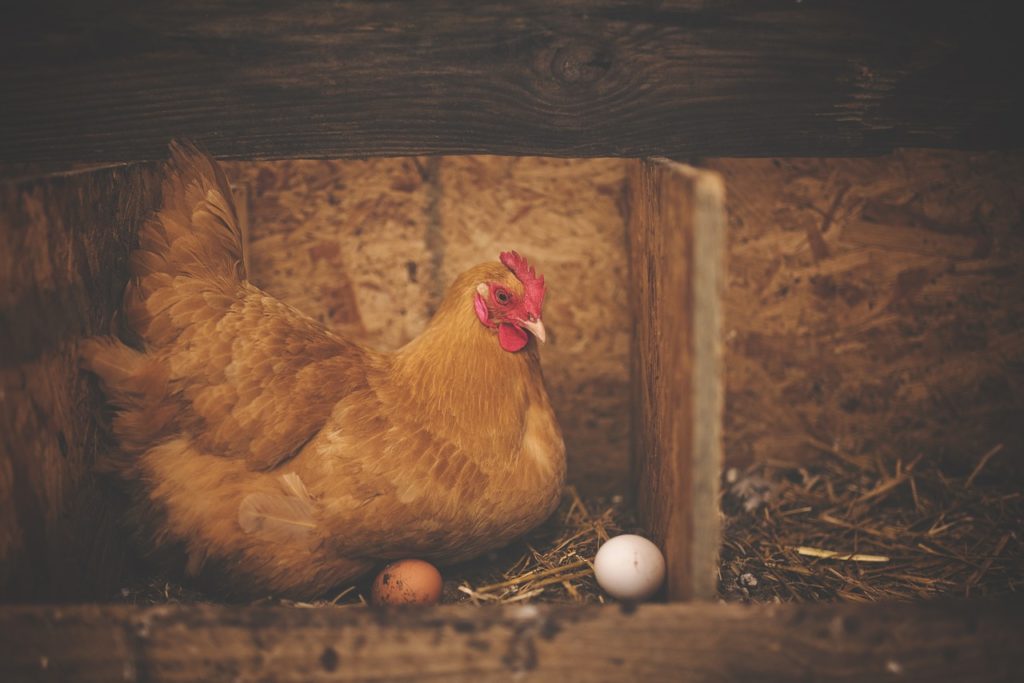
Once your pullets begin to lay eggs, you can start to feed them layer feed.
This will have about 16% protein and is designed specifically to support the needs of egg-producing chickens.
Specifically, it has more calcium.
It is very important that you do not feed your chickens laying feed until they are actually laying.
You should not feed roosters layer feed, either, because the excess calcium can damage the kidneys of chicken who are not producing eggs.
Otherwise, layer feed can make up the core of your laying flock’s diet.
It doesn’t contain as many vitamins as chick starter might, but it will have extra calcium and ample amounts of protein to meet their needs.
Also Read: 20 Best Egg Laying Chicken Breeds
Can I Make My Own DIY Chicken Feed?
You sure can!
One of the biggest benefits of raising chickens is inexpensive eggs and meat – but if you’re shelling out hundreds of dollars on food, you’re obviously not saving any money.
If you are going to make your own chicken feed, we recommend using organic ingredients to make sure your chickens get a good balanced diet without any unnecessary chemicals, fillers, or additives.
You can include the following ingredients in your homemade chicken feed, but make sure you measure them out and consider their individual nutritional value so that your chickens receive all of the nutrients they need:
- Corn
- Wheat
- Sunflower seeds
- Barley
- Peas
- Lentils
- Quinoa
- Sesame seeds
- Kelp
- Wheat bran
- Mealworms
- Sesame Seeds
- Peanuts
- Sprouted Seeds
- Dried berries
- Millet
- Kamut
- Flax seeds
- Brewer’s yeast
How Often – and How Much – Should I Feed My Chickens?
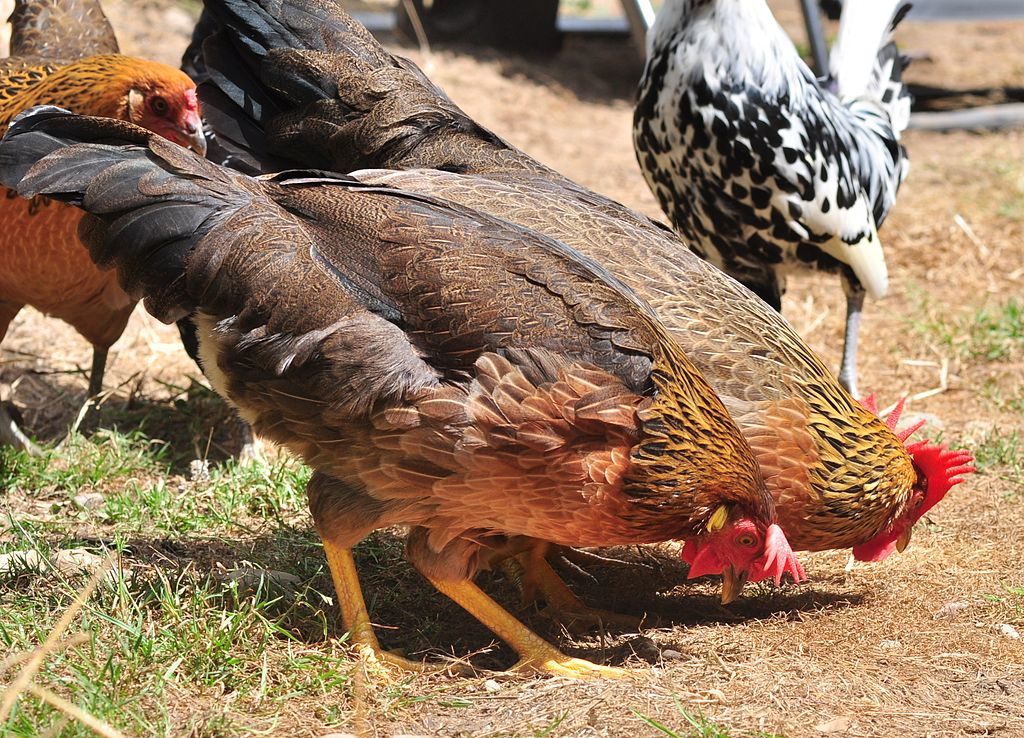
Your daily feeding schedule will depend on a variety of factors, including how many chickens you have, what kind of living conditions you have them in, and what time of year it is.
In general, the average hen will eat around a pound and a half of food each week.
Of course, this is an average.
Small birds will eat less, and chickens will eat less in the summer, especially if they have access to fresh posture.
To make your life easier, we recommend feeding your chickens free choice.
This means you hang or place the feeders somewhere in the coop or run, and let the birds go to town whenever they feel like it.
In general, most chickens won’t sit at the feeder and gorge themselves all day.
The exception to this is some breeds of broiler chickens that were bred solely to eat and produce meat – breeds like Cornish Cross chickens are known for parking it at the feeder and eating until their hearts give out.
However, most breeds of chicken will stop eating when they are full.
Free choice feeding can thusly make your life easier because you won’t have to bring out feed at set points for the day, and it also limits bullying behavior – if the chickens have access to food all day, each chicken will be given an opportunity to eat at some point.
Types of Chicken Feeders
After you have decided what kind of feed to give your chickens, you will need to invest in some feeders to get them going.
If you already keep chickens, you probably already know that they couldn’t care less about how you feed them – as long as there’s plenty of food to go around, they’ll eat right off the ground!
However, putting your chicken feed in a feeder that is specifically designed for a backyard flock will preserve the freshness of the food and also help to prevent waste.
When you’re selecting among types of feeders, you have two basic choices: gravity feeders and automatic feeders.
Automatic Feeders
Automatic feeders can be more expensive, but they save quite a bit of money in feed expenses.
The feed is enclosed inside a container, meaning you won’t have to worry about spoilage during rainy days.
The container also helps prevent rodents and insects from getting inside the feed and spoiling it.
These feeders work in a relatively simple fashion – A hen will stand on a pedal to open the box and she can then access the feed.
This kind of simple system is easy for the hens to figure out, and can save you some serious cash.
As we mentioned, though, automatic feeders are more expensive upfront.
Therefore, many backyard chicken keepers invest in gravity feeders – these tend to be more common and significantly less expensive.
Gravity Feeders
Gravity feeders can be made out of plastic or galvanized steel.
Galvanized steel containers are more durable and better for use outdoors during the winter (they won’t crack like plastic) but you have to be careful about cleaning them with vinegar – they can leach dangerous metals into your chicken’s food supply.
Strong galvanized steel feeders are designed to withstand the pressures from chickens standing on top, but most don’t feed out through the top, anyway.
A majority of gravity feeders will shoot food out at the bottom via a circular tray.
You fill up the feeder at the top and as your chickens eat, the tray on the bottom fills back up.
These kinds of feeders can be hanging, wall-mounted, or free-standing.
Chicken Waterers
Many people don’t include water in their thoughts of how to feed their chickens, but it’s something that definitely needs to be taken into consideration.
A lack of good, clean water can make your chickens hesitant to eat.
A chicken drinks lots of water throughout the day, taking it in one tiny sip at a time.
In order for your chickens to function properly, they need access to fresh, clean water at all times.
One chicken drinks about two cups of water each day, and older chickens drink a lot more than younger ones.
Layers will drink more than non-layers, and all chickens will drink twice the amount they normally do during periods of hot weather.
Laying hens that don’t get enough water will not only begin to lay poorly, but they also will be more likely to go into a molt (halting egg production) and go off their feed.
The bottom line?
In addition to providing your chickens with free-choice food in a feeder, you also need to make sure they have plenty of water at all times.
You’ll change the birds over to grower feed at six weeks old (grower feed has about 18% protein).
Chick feed, as you can see, is much higher in protein and contains all the vitamins and minerals your chicks need to get off to a good start. It is lower in calcium than layer feed.
Should I Give My Chicken Treats?
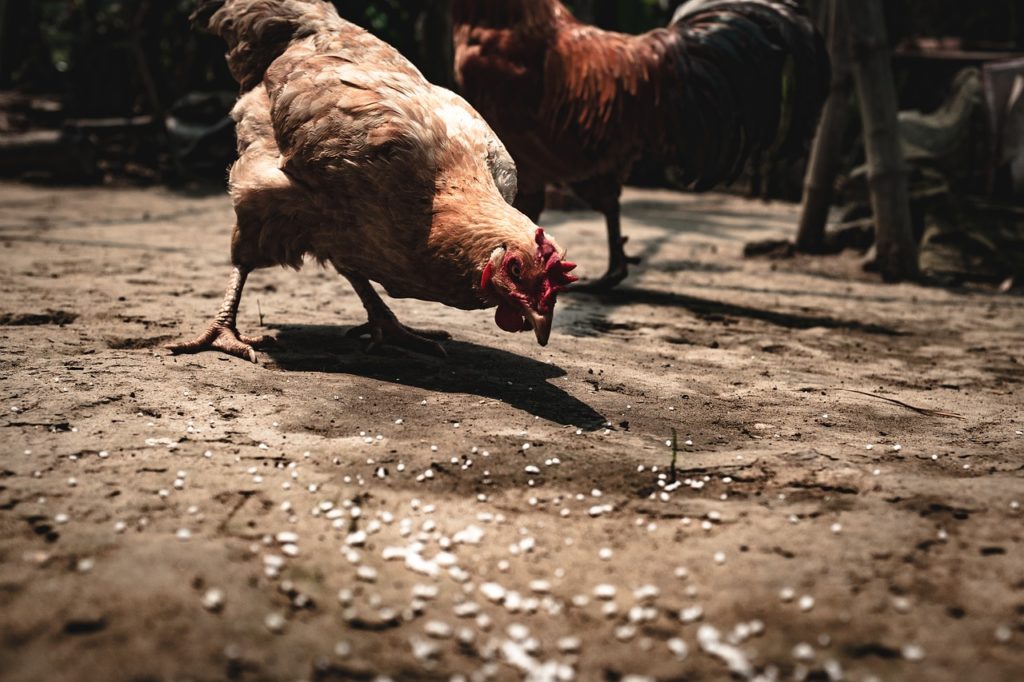
While a chicken needs a good, solid diet based on a formulated feed, there’s no harm in giving your chickens treats from time to time.
Feed treats can encourage good behavior and reduce boredom in your flock, and it’s also a great way to use up any leftover ingredients you have lying around the house.
You should not provide your chickens with more than 10% of their daily nutritional requirements in treats.
A good rule of thumb is to only give your chickens treats just before they are about to roost in the evening and have already consumed most of their nutritional needs for the day.
You can toss down a handful of scratch into the coop to keep them busy.
You might want to feed additional treats in the winter, however, because your chickens are more likely to become bored during this time.
Giving your birds treats to keep them warm and occupied will prevent bullying behavior and also give them a way to exercise.
The key to feeding your chickens healthy treats is that they should be nutritious and not filled with empty calories.
Of course, all treats should be fed in moderation, too!
Here are some good options to consider:
Berries: Chickens love all fruits, but berries are great treats because they are so small. Consider tossing a few blackberries, raspberries, or blueberries into the chicken yard – bonus points if it’s summer and you freeze them first! Extra hydration equals extra fun.
Fresh Vegetables: Consider hanging a head of lettuce or cabbage in your chicken coop. This can help ease boredom in your flock, especially during the winter, and it also provides lots of fiber, vitamins, and minerals to your flock.
Mealworms: Mealworms are another popular treat for your chickens. You can purchase these at the store or you can make your own at home. They are high in protein so you should only feed a spoonful per day at most.
Scratch Grain: Chicken scratch, or scratch grain, is a common store-bought treat. It has little nutritional value but can be fed to your chickens every few days. Scratching is a natural chicken behavior that should be encouraged, and scratch grain will entice your chickens to do this.
Bird seed: Store-bought bird seed is a perfectly fine addition to your chicken’s diet, as it will contain healthy fats and proteins in the form of sunflower seeds and other natural ingredients.
Suet: You can purchase suet cakes or make your own at home – just remember that these are high in fat and are best left for the winter time or other times when your chickens will be confined to the chicken coop.
Crickets: Crickets are full of protein, fat, and minerals for your chickens. These can definitely be fed in moderation to your chickens.
How Can I Save Money on Chicken Feed?
Making your own chicken feed is a great way to save some cash on feeding your flock.
In order to do this, you need to make sure you are meeting the exact nutritional requirements of your birds.
It can develop mold after some time, too, so it’s important that you keep this in mind if you are trying to store feed in the long term.
What is Fermented Feed?
Many people use fermented feed as a way to save money in feeding their flocks.
Fermented feed is actually better for your birds, as it releases a lot of the nutrients that are locked into the grain and therefore unavailable for your birds.
Fermenting feed involves soaking the grains in water.
It stretches the dollar since you will use less feed and is an easy process to do.
It takes little time and your hens will benefit from the extra calories.
What are Good Table Scraps for Chickens?
In addition to providing your chickens with good feed, they can also be fed common leftovers and ingredients you might have laying around the house.
This can help save money and also reduce your impact on the environment, as you will be producing less household waste.
Here are some of the best foods you can feed to your chickens:
- Fruit and vegetable scraps and peels
- Milk, yogurt, and cheese
- Bread products (in moderation – too many carbohydrates can make your chicken sick)
- Cooked meat (just trim off any excess fat)
- Cooked eggs (avoid raw eggs, as this can encourage egg eating in your hens)
- Grass clippings
- Compost
- Nuts and seeds
- Cooked rice and pasta
- Cereal
- Cat and dog food
- Popcorn
- Dried fruit, like raisins
- Pumpkins
- Flowers (just make sure you don’t feed them any toxic flowers)
- Oats and oatmeal
- Sunflowers
- Quinoa
- Garlic
- Herbs (certain herbs like basil, mint, and oregano are extra-healthy for your flock)
When – and Why – Should I Feed Grit and Oyster Shell?
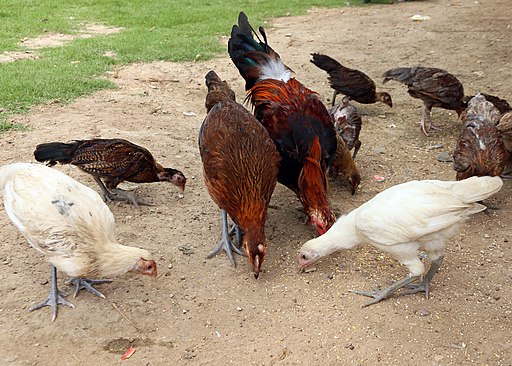
Grit and oyster shell are two other crucial ingredients in your chickens’ diets.
Grit is necessary for all birds to be able to process food. If your chickens don’t free range, you will need to provide grit in order for them to digest their food.
This should be offered free-choice in a separate dish besides the feeder.
Grit is basically just tiny rocks, often flint.
These rocks help chickens digest food in their stomach s(also known as their gizzards) by grinding it up.
Chickens don’t have teeth, so the grit essentially “chews” the food for them.
You will also need to give your laying hens oyster shell.
It’s not a necessity – and actually not recommended – for birds who are not laying. Therefore, you should not mix it into the feed but instead offer it separately.
Oyster shell will provide your birds with the calcium they need to produce strong, healthy shells and to prevent bone development issues as your birds continue to lay.
If you don’t want to spend money on oyster shell, you can always cook the egg shells from your chickens’ eggs after you’ve used them and then grind them back up to be fed to your birds.
What Foods Should I Not Feed My Chicken?
Here are some of the foods that should be kept far away from your flock.
- Onions: Onions contain lots of vitamins and minerals, and while an onion or two may not hurt your chickens, too many can cause a condition known as hemolytic anemia.
- Raw Potatoes: It is perfectly fine to feed cooked potatoes to your chickens, but we should avoid feeding them raw potatoes. This is because the green part of the potato contains solanine, a poisonous compound. The same rule applies to the parts of the potato plant, like leaves and flowers – potatoes are members of the nightshade family and are incredibly toxic
- Chocolate: Save the chocolate for yourself – you aren’t being greedy. Chocolate contains theobromine, which is toxic to many animals, including dogs and of course, chickens.
- Avocadoes: Avocados contain person, a compound that is toxic to chickens. Although the flesh is technically safe to eat, you’re best just to leave this one in the trash.
- Apple Seeds: Apples themselves are usually fine, but apple seeds contain cyanide, which in high amounts can be toxic.
- Eggplant: Avoid feeding eggplant, which, like potatoes, contains solanine.
- Anything You Would Not Eat Yourself: Some people use their chickens as a natural garbage disposal, giving them everything from rotting meat to moldy bread. Now, there’s some legitimacy to this – chickens love maggots, after all. However, you should try not to feed your chickens too many foods that you would not eat yourself, as this can impact their health.
- Uncooked Beans: Chicken cannot be fed uncooked beans, as they contain deadly phytohemagglutinin.
- Rhubarb: Rhubarb contains high amounts of oxalic acid -this can kill your flock.
- Coffee Grounds: You should try to avoid giving your chickens caffeine. It won’t necessarily cause a lot of damage, but there’s no nutritional value here, either.
- Citrus: Citrus won’t cause any negative effects in your birds, but most chicken owners report that their birds won’t touch it for whatever reason.
- Green Tomatoes: Like potatoes and eggplant, tomatoes are nightshade vegetables and contain solanine and chaconine – these can kill your chickens. Even if you cook your green tomatoes, it will not remove the toxins.
- Anything Salty, Sugary, Highly Processed, or Alcoholic: For obvious reasons, we hope!
- Plants Treated with Pesticides: Avoid feeding your chickens any kind of plant that was treated with chemicals. If it’s not good for you, it’s not good for them.
Tips for Feeding Chickens
You do not need to feed organic feed if you are not interested in organic egg or meat production.
Often, there will be no difference in the growth of your chickens if you switch over to an organic feed, but does have some benefits in that it is non-GMO and is often locally sourced and produced right in the United States.
You can purchase feed that is free of soy, corn, or other ingredients.
This often costs more, but may be worth the money if those are factors that matter to you.
Keep in mind that while you want to read the labels of your chicken feed closely to make sure it isn’t loaded with additives or other dangerous ingredients, a chicken food that costs more because it is “vegetarian” is not worth your money.
Chickens don’t need vegetarian feed – they are omnivores!
Whenever you make a change to your chickens’ diet, make sure you do so gradually. An abrupt change can cause digestive upset including diarrhea and other issues.
Make sure you store your chicken feed in a dry location where rodents and other pests will not have access to it.
A good idea is an inexpensive outdoor trash can with a clipped-on lid so that animals (including your chickens!) can’t get into it.
If you find that your chickens aren’t eating as much as usual, this could be because they are stressed.
Make sure your chickens are housed in a quiet location and there are no predator threats nearby.
Ensure that the birds have plenty of shade as well as a draft-free coop to provide for good body temperatures, and stick to a steady diet with little changes or fluctuations.
Why Is It Important to Feed a Proper Diet to My Chicken?
Consider our suggestions, and figure out the feeding plan for your flock that works best for you.
Not all chickens are built alike, so developing a plan that works well for your own situation is vital.
A healthy chicken is a happy chicken – and it’s also a productive one.
By feeding your chickens a nutritious, well-rounded diet, you will be able to sustain a flock that will provide you with eggs, meat, and/or entertainment for years to come.
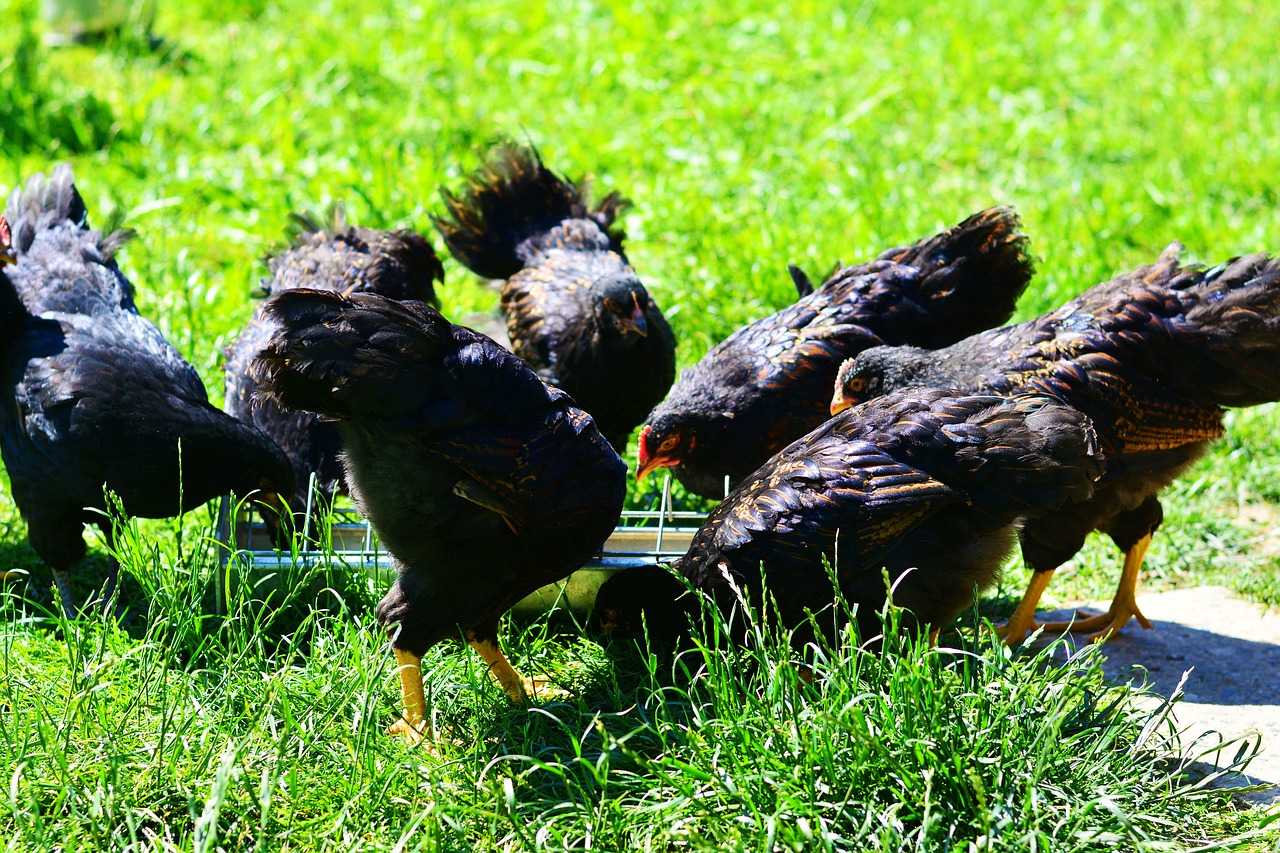
How much feed (in combination of
Ingredients) does each bird need per day? For example, is four ounces per day per laying hem a good
Rulle
Of
Thumb?